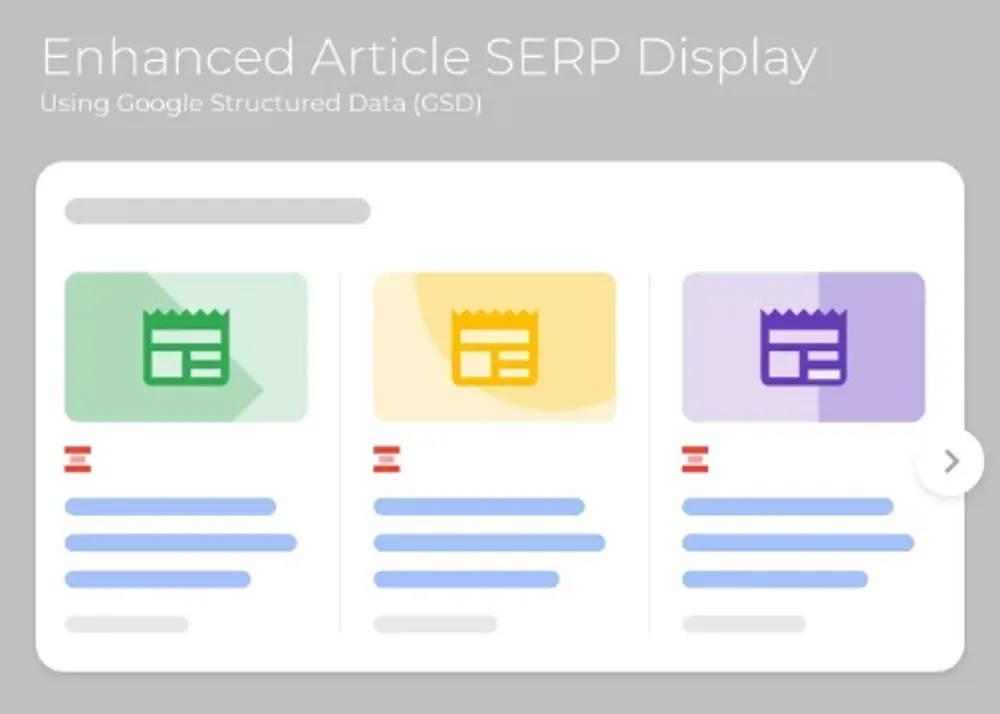What is Google Structured Data (and why should I care about it?)

You know those pretty listings you see on a Google search … the ones that list all the main categories of a website, or that show a product listing complete with description, photo and price? Don’t you love the results that show the ingredients and calories of a recipe? Have you ever wondered how to get your blog posting to show up in Google “People also ask” dropdown boxes, or how to get your job posting to show up with specific job requirements and salary ranges?
If your SERP (Search Engine Results Page) results are just sad little “Title + description” blurbs, it’s time to apply Google Structured Data to your web articles and pages. Google Structured Data is back-of-the-website code that tells Google how to interpret and display search results.
Why Structured Data Matters
Structured Data is exactly what it sounds like; data that is structured. For example, the sentence “Mark Scanlong, who has a master’s degree in applied mathematics was born in 1960 and received his graduate degree from MIT” is unstructured data. The structured data equivalent would be:
- Candidate: Mark Scanlong
- Birth Date: 1960
- Graduate Degree: Applied Mathematics
- Institute: Massachusetts Institute of Technology
Structured data is faster and easier for both computers and humans to digest. For example, poor sentence structure can be confusing and a reader may spend several seconds sorting out the relationships between names, dates and places. For a computer, the interpretation may be more challenging. For instance, a computer may not automatically know that “Mark Scanlong” is a person and not a company, or the best way to convey his degree. Structured data makes the relationships between points clear even if the writing is somewhat ambiguous. Offering your website content as structured data is a more reliable way of making sure website visitors understand and retain your information.
Google wants more of its search results presented as structured data, because they want more of the search activity to be satisfied on the search results page. Some people object to that goal, because they want to get searchers to click on results and visit web pages. They fear that if all the searchers can find answers on the SERP page they won’t have to visit the website. In fact, website visits may drop slightly, but there is solid evidence that good GSD search results yield more qualified visitors. If you get fewer overall clicks but higher overall qualified customers, everybody wins.
Types of Structured Data
There are many different types of structured data, and each has its own display or format. Here is a list of GSD types as of this date:
- Article
- Book
- Breadcrumb
- Carousel
- Course
- Dataset
- Education Q&A
- Employer Rating
- Estimated Salary
- Event
- Fact Check
- FAQ
- Home Activities
- How-to
- Image Metadata
- Job Posting
- Learning Video
- Local Business
- Logo
- Math Solvers (great for any calculation needed in your industry or profession)
- Movie
- Podcast
- Practice Problems
- Product/Service
- Q&A
- Recipe
- Review Snippet (critical reviews)
- Sitelinks Search Box
- Software Apps (still in beta as of 11/7/2022)
- Speakable (news that can be read aloud)
- Subscription and paywalled content
- Video
Each of these categories are different code formats that can be applied on the back-end of your website. When Google reads these code formats, three things happen: 1) Google can quickly interpret what is on the page and its specific value to searchers, 2) Google can instantly categorize the data, which helps propel your information higher in the SERP, and 3) Google can easily display the content in the most effective, relevant way, i.e.; recipe cards for recipes, Q&A dropdowns for questions and answers, and simplified basic instructions for how-tos.
Rich Snippets
Presenting structured data in the form of rich snippets helps Google do its work faster and more effectively, and allows Google to deliver results almost instantly to users.
Each day millions of new pieces of content hit the internet and the internet becomes more complex. To keep the internet as usable and efficient as possible, structured data is required. As powerful as Google’s search engine is, it still has limited power and interpretive capacity. Google also has a goal of providing the most useful and relevant results to its users’ queries. Structured data allows a website to talk directly to Google bots, telling the bots which details to highlight and how to organize the results. Google calls these organized displays rich snippets.
There is no guarantee that Google will create a rich snippet if you provide the structured data. But it’s still worth it to put the structured data on your site and hope that Google will pick it up! Every piece of structured data you manage to get into the SERPs is another opportunity to recruit more qualified leads so you can turn them into customers.
You can learn more about all GSD types here: https://developers.google.com/search/docs/appearance/structured-data/search-gallery
Andrea Hill's
Latest Book
Straight Talk
The No-Nonsense Guide to Strategic AI Adoption

Where other books focus on prompts and tools, this book gives business leaders what they actually need: the frameworks and confidence to lead AI adoption responsibly, without having to become technologists themselves.
Also available at independent booksellers and public libraries.
Are You Ready to Do Better Marketing?
WerxMarketing is all about performance marketing. That means giving you the tools you need to connect with customers, enable your sales efforts, and turn leads into loyal customers. Ready to learn more about how we do that? Book a free consult and bring your questions. See if you like working with us on our dime, and get some good advice in the process.